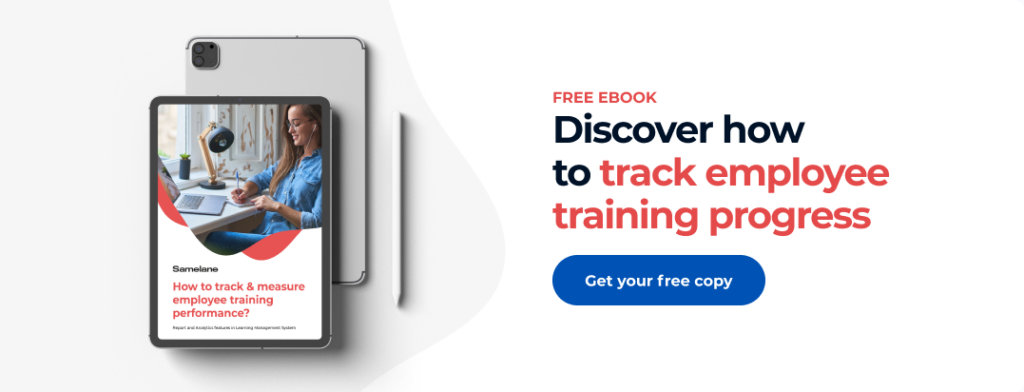Learning strengthens people’s sense of belonging and significance in what they do. It is a foundation for mutual trust, support, and collaboration. Organizations that invest in learning and development can expect their employees to be more willing to invest their energy and effort toward the company’s success.
Current trends reflect this commitment to education. According to 2024 LinkedIn Research, 40% of organizations have developed full-grown career development initiatives. Most of them offer online learning programs as a key component. This focus on L&D highlights its strategic importance in building a skilled, engaged, and motivated workforce. Modern educational systems, such as LMSs, support learning initiatives on a broad scale.
What Is an LMS Platform and What Functions Does It Serve?
A Learning Management System (LMS) is a software application designed to efficiently and coherently manage learning processes in an organization. It allows users to create and deliver various courses, develop training programs and educational paths, monitor the status of a given course, and generate reports on learner progress and completion rates to identify potential areas for improvement. Additionally, such a system offers multiple course optimization and automation options, which leads to significant savings.
While e-learning platforms and Learning Management Systems (LMS) are sometimes used interchangeably, LMSs offer a significantly more comprehensive solution designed to address the complex needs of enterprise Learning and Development (L&D). The article comparing these two solutions offers more on the topic.
LMS Market Growth
The growing importance of employee training has been consistently observed for years, whether initiated by employers or employees. This process results in dynamic growth in the market of educational platforms and online courses. According to MarketsandMarkets, a market research publisher, the Learning Management System market is expected to grow from USD 22.1 billion in 2023 to USD 51.9 billion by 2028.Hundreds of entities worldwide provide learning management system solutions; moreover, some companies build their platforms for internal needs. Such availability is reflected in the variety of solutions offered. Multiple platforms only provide basic functionalities and should be instead called e-learning platforms, but numerous others use the latest technologies, including artificial intelligence (AI) and augmented reality.
How Does A Learning Management System Work?
A Learning Management System (LMS) provides a centralized platform for managing all aspects of the learning process, from creating and delivering courses to tracking learner progress and reporting on training effectiveness. We can divide its core functionalities to five groups:
1. Content management
LMS acts as a digital library where learning materials like documents, videos, presentations, simulations, and SCORM (Sharable Content Object Reference Model) packages can be stored, organized, and easily accessed by learners.
2. User management
Administrators can create user accounts for learners, instructors, and other stakeholders. They can also assign roles and permissions, controlling who can access specific courses and functionalities. Learners can register for courses, log in to the learning management system, and manage their learning processes.
3. Course creation and delivery
Modern LMS platforms offer built-in tools that allow instructors to create engaging online courses with interactive elements like quizzes, polls, and assignments. Instructors should also be able to import pre-made courses into the system. L&D managers can design personalized learning paths by sequencing learning materials and activities to meet users’ learning objectives.
4. Assessment and evaluation
An LMS can deliver online quizzes, exams, and other assessment methods to verify learner knowledge and skills. These assessments can be automatically graded, providing immediate feedback to learners. The system can also facilitate surveys and feedback mechanisms, allowing instructors to gather insights into learner experience and adjust the courses.
5. Reporting and analytics
A learning management system allows managers and instructors to track learner progress, including course completion rates, performance, and activity time. LMS platforms generate reports that provide valuable insights for administrators and trainers for greater convenience. Administrators can use these reports to evaluate the effectiveness of training programs, identify learning gaps, and make decisions about future training initiatives.

LMS Functionality For Big Organizations And Medium Businesses
Due to the scale of their operations, large corporations were undoubtedly the first to recognize the need to implement automation and efficient L&D programs, but this does not mean that medium-sized enterprises cannot use the exact solutions. That is why Samelane offers pricing plans for even up to 100 users or per-user payments.
Stationary employee training requires a lot of time and considerable financial expenditure, including problematic scheduling, potential transport to/from classrooms, accommodation, allowance, etc., no matter the company’s size. Of course, the return on investment will be more recognizable for enterprises, but by transferring training to e-learning platforms, smaller businesses can also experience significant savings.
Learning Management Systems available in the market may appear similar at first glance, but they are designed to serve different user groups. Apart from the standard functionalities analyzed in the previous section (content and user management, course creation, assessment, and reporting), enterprise-level LMS should also meet other criteria.
Thus, a Learning Management System for large enterprises means more than finding a course delivery platform. An in-depth analysis of the current and future business needs and goals should always precede the choice.
The most important functionalities of advanced Learning Management Systems include:
Variety of training formats
State-of-the-art LMSs must support various formats to enhance user engagement and utilize existing resources, such as audio, video, video 360, SCORM, PowerPoint, and TinCan. Less common but worth considering are Virtual Reality (VR) and Augmented Reality (AR) courses and the use of Conversational AI for greater assistance and accessibility. This variety addresses different learning styles, improves learning retention, and, as a result, maximizes the effectiveness of training programs.
Certification paths
Dedicated certification programs have become a strategic function for large organizations with specialized training needs. Certifications offer long-term benefits: ensuring compliance with industry standards, verifying employee skill sets, supporting career advancement opportunities, and enhancing the organization’s reputation. Pursuing certifications impacts employee motivation and work engagement.
Training provision
In providing training courses, it is essential that a learning management system offers the possibility to formulate automatic rules. Thanks to them, appropriate training sessions can be assigned to specific employees in a fully automated manner.
Similarly, training sessions, which should be conducted periodically, can also appear in the panel of a particular employee without the need for additional activity on the part of the platform administrator, such as an HR specialist. LMS tools for HR allow the administrator to assign the course to a specific employee or group and introduce a cyclical rule.
Monitoring and reporting
An extensive monitoring and reporting system is necessary to manage the training process and evaluate its outcomes efficiently. It allows supervisors to track employees’ progress, monitor the completion of specific courses, create a competency matrix for individual teams, and consequently enable precise planning of further L&D initiatives. The system should update data in real-time with 24/7 access.
The possibility of conducting an in-depth training data analysis allows companies to quickly identify competency gaps among employees, monitor individual training course completion status, and analyze participant feedback. L&D managers can use survey results to improve the training process and current educational materials.

The Benefits of a Learning Management System
Investing in a modern e-learning platform brings several benefits – both that can be accurately estimated and those that are less tangible. The most important ones undoubtedly include:
- Business growth: Drives achieving business goals through continuous employee development and skill-building initiatives.
- Centralized processes: The ability to manage the process of upskilling and reskilling in the company comprehensively and, importantly, in a single, user-friendly application.
- Knowledge retention: Arranging the know-how in the organization and thus maintaining business continuity in the event of a sudden absence of key employees.
- Actionable insights: Thanks to access to advanced reporting options, managers can quickly identify possible competency gaps and take appropriate remedial steps.
- Cost & time efficiency: Eliminates time and resource waste associated with traditional training methods like scheduling in-person courses, reminders, and manual assessments.
- Personalized learning paths: The possibility of creating dedicated learning tracks supports achieving the organization’s goals, employees’ personal development, and job satisfaction.
Smart Education In Practice: How To Choose The Right Platform?
The demand for individual functionalities of Learning Management Systems platforms goes beyond just company size. While a medium-sized accounting firm might prioritize features like compliance tracking and certification management. Plus, a manufacturing company’s needs are more complex: providing obligatory hands-on training resulting from applicable law or the introduction of new tools and machinery.
In the first case, an educational platform with standard functions would probably suffice. The training of financial department employees usually does not require reaching for interactive and technologically advanced solutions.
The situation differs in companies or departments where long-term employee onboarding and training processes are common. In such cases, a better choice would be a learning management system, offering, for example, an Augmented Reality module enabling the creation of engaging implementation training with models of machines and devices that the employee will have daily contact with. Such an innovative solution wouldn’t be less effective than stationary training but would generate considerable savings and wouldn’t disturb the continuity of the factory’s operations.
Choosing the right LMS platform isn’t a one-size-fits-all solution. By understanding the specific training needs of your organization, you can unlock the true potential of Learning & Development initiatives, empowering your workforce and propelling your business forward.











